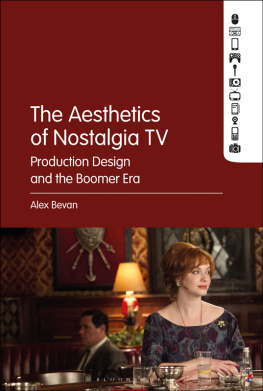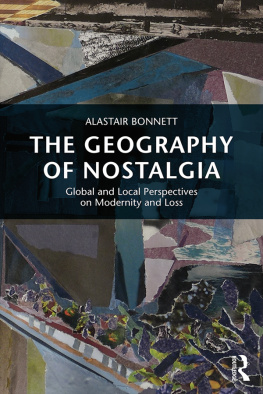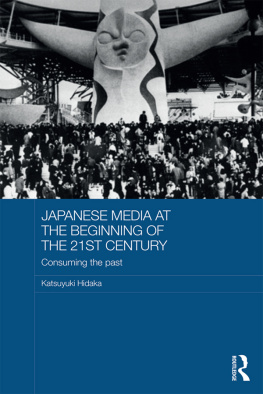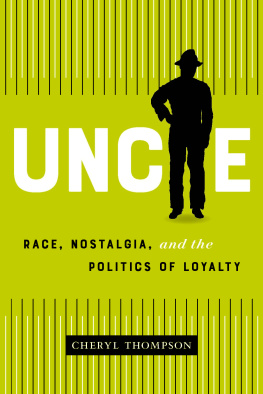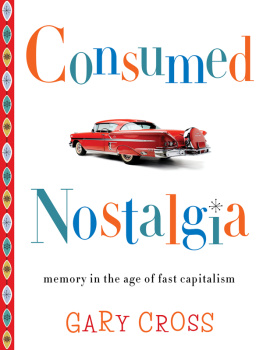The Aesthetics of
Nostalgia TV
The Aesthetics of
Nostalgia TV
Production Design and the Boomer Era
ALEX BEVAN

This book is dedicated to my favorite person, Luc.
T hank you to everyone in the industry who was so generous and open to sharing work with me. Im truly humbled by the warmth and trust of those working in art direction and costume design. This could not have been written without you. Thank you Regina Stewart for placing me in contact with people. Thanks to Bonnie Nipar, Janette Kim, and Charles Gooden and Daniel Bertin at ABC for talking with me and sharing their contacts. Thank you to Janie Bryant and Eduardo Castro whose extraordinary talents are only rivaled by their kindness. Thank you to Pam and Jim Elyea of History for Hire, Inc., for talking with me, letting me roam around their prop warehouse, and giving me key insights into the prop industry. They also bought me lunch and invited me to a wrap party, which is more glamor than Im used to as a mealy mouthed academic. Thanks to Keith Marvin and Dan Schultz at Prop Heaven for the visit and chat. Thank you to Western Costume Company and the invaluable words of Eddie Marks, its owner, and Bobi Garland, its head research librarian. Thank you to Sony Pictures Prop Warehouse for letting me walk around. Thanks to Rosemarie Knopka of the Art Directors Guild Research Library and Archive, and to Archie DAmico, Ellen Brill, and Kathy Orlando for their guidance and time. Thanks to Carlos Barbosa for being so generous with his time during very busy a pre-production schedule. Thank you to Ellen Freund and the crew I met that day that somehow found time in the very last phases of production to talk to me and give me such a unique insight into a very special show. Your crew is truly made of magic.
Im indebted to the mentorship of Professors Diane Negra, Jake Smith, Lynn Spigel, Scott Curtis, Jeffrey Sconce, and Hamid Naficy. I also want to thank new friends and colleagues at the University of Queensland in Brisbane who helped me through the final stages, particularly Tom ORegan, Nicholas Carah, Dan Angus, and Lisa Bode. Thank you to the BLAT research group at the University of Queensland and its members Tom ORegan, Lisa Bode, Nat Collie, Skye Doherty, and Caroline Wilson-Barnao. Thank you Professor Brian Lucid and Professor Julieanna Preston at Massey University for fostering my growth as a researcher. Thank you to Vanessa Gerrie for helping with copyediting.
I want to thank Bloomsbury Press for their professionalism, promptness, and transparency in communication. Thank you to Susan Krogulski and Erin Duffy for weathering my email pestering and Katie Gallof for seeing the potential of this project and cheering me on.
Thank you to my peers and friends who have been huge supports over the years, particularly those who listened and helped us through two challenging international moves: Radha OMeara, Darrny Wolfsbauer, Karl Kane, Grant Bollmer, Jo Bailey, Miriam Ross, Kathleen Kuehn, Shannon Friday, Nick Holm, Lucy Langston, Sy Taffel, Jo Vitkovitch, Tanya Marriott, Garry Buckley, Hannah Hamad, Ian Huffer, David Gurney, Brendan Kredell, Hannah Gerrard, Jason Roberts, Elizabeth Lenagan, Neha Kamdar, Elizabeth Nathanson, Hollis Griffin, Cary Elza, Catherine Clepper, Dan Bashara, and Linde Murughan. I also want to thank all of my students over the years who continue to teach me as much as I teach them. Also thank you to anyone who has ever been a blind peer-reviewer of any of my publicationsIm indebted to the kind words and constructive criticism of those generous, anonymous people.
Lastly, thank you to my family. In particular, I want to thank my brilliant brother Rhys Bevan, my dog Iggy, and my wonderful husband Luc Miknaitis for seeing us through this journey.
P rominent mens rights activist, Jordan Peterson, claims that the last time gender roles truly benefited society was in the 1950s. Indeed, across English-speaking countries in particular, the baby boom years retain a symbolic potency, especially in the late twenty teens as mens rights activism and alt-right political movements increase in visibility. What first made me want to write this book was my love for these television shows, which I read as self-aware reflections of American pastness. Their nostalgias were complex and riddled with contradiction, and their aesthetics and design elements were equally dense and political. However, in preparing it for publication, the timeliness of a book on US nostalgia in the context of the global rise of ethno-nationalism feels equal parts an opportunity and a burden. The political weight of these shows about white yesteryear has never felt more important and pressing.
The main argument of this book is that the design that goes into these nostalgic shows and the creative processes underlying it reveal more complex, meaty cultural politics than simple celebrations or castigations of the past. Rather the shows are sober reflections on past eras and their gender, racial, and class inequities. Mad Men (AMC, 200715), Ugly Betty (ABC, 200610), Desperate Housewives (ABC, 200412), and even industry disappointments like Pan Am (ABC, 201112) and Aquarius (NBC, 201516)these American shows are troubled, to borrow Professor Tom ORegans term for them. American television drama, traditionally, has been troubled, starting with the early teleplay network anthologies of the 1940s. Im also publishing the book at a troubled time in American history and, indeed, world politics in the context of mounting political fractures between conservatism and progressivism.
At first, I wrote an admittedly melodramatic and churlish preface about how, progressive design politics and meanings aside, I should have seen these shows as the inevitable death knell of a democracy in rapid decline. I circulated the preface in my research group at the University of Queensland and my Australian colleagues were a little taken aback by my American-centric, emo kid bitterness (my words, not theirs). I was waxing nostalgic for my own Obama-era first encounters with boomer nostalgia, which, in the wake of the 2016 election and Brexit, now seem callow. In an email exchange about the preface, Lisa Bode writes of Mad Men:
I concede that the show can be seen in retrospect as emerging from a naively optimistic view of history as socially progressive (rather than cyclical and involving a constantly shifting dialectic between reactionary conservatism and liberalism). But in doing so it presents an argument or desire (through the emotional attachments we are encouraged to have to the rising fortunes of Peggy and Joan) for the way things *should* be That said, I dont think Mad Men is totally optimistic: the ending of the show indicates that progressivism as a cultural mood can be co-opted and sold back (Id like to give the world a coke) by the privileged white man in advertising, and that everything is always provisional (history is just like TV in that way).
Lisa refers to the end sequence of the series in which our boomer, patriarchal protagonist and advertiser extraordinaire, Don Draper, ends his crippling struggle with sex addiction and alcoholism by recovering in the most unlikely of placesa hippy commune. Happily for him, this moment of personal recuperation coincides with and catalyzes the inspiration for the epitomic 1971 Coca-Cola commercial, which the series implies Don Draper authors. Mad Men and other TV forms of gender and racially charged national nostalgias center on critical views of the past premised, not necessarily on the assumption that society has progressed, but on the way things should be, as Lisa put it, even while they admit this is not exactly the way history went down.
Next page
